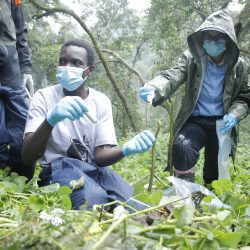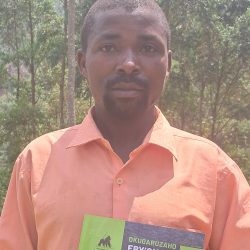Walking Under the Volcanoes’ Shadow with the Batwa
Blog | 16/12/09
The moss drips from the trees surrounding the camp in a filigree of light and delicate wisps of the bright green and earthy chocolates of the rainforest. We sit on a bamboo bench with the smoking shacks in front of us looking like they are being swallowed by the forest’s creeping wildness. The twisted tree branches clatter with the caw of the local crows as the Batwa guide explains what we are about to embark on. This is the realm of the Batwa (pygmy) peoples: a forest full of sustenance, shelter and medicine. The spiritual ground of a people who may no longer harvest its riches, but who will be forever woven into its small wonders and daily cycles – the essence of what brings this richly diverse land to life.
Stephen, our guide, tells us the story of the Batwa people before clapping his hands loudly and bowing down to the muddy earth on this overgrown path perched on the side of the mighty Murhavura volcano: a king had three sons who were brothers and put them in a shelter one night, all with a container of milk. The first drank the milk and spilled the rest while sleeping. The next drank the milk but did not spill it. The third had the patience not only to not drink the milk and not spill it, but to stay up all night and guard for any dangers or spirits that might float in and do harm to his family and the community. The third brother had discipline, will and talent: he was trusted to lead his people out into the forest, and his offspring became the Batwa.
Stephen’s hand clapping and bowing was a simple request to God to keep the family back at home safe while we entered the wild unknown. These days, the two volcanoes that make up Mgahinga Gorilla National Park, Murhavura, a jutting sloped mass akin to a massive ocean wave on the verge of toppling over, and Gahinga, its flat-topped pipelike sister, are still wild, but better known. Gorillas families often plied the slopes of these two rugged masses crowding Uganda’s border with Rwanda, but lately better “salad bowls” in Rwanda and the Congo have left the Park without a main revenue driver. I find out, however, that one family suddenly reappeared again a couple of months ago, bringing new hope and tourists, but the densely populated human communities ringing the Park are still in need of alternative income sources to supplement their subsistence farming.
This walk through Batwa history and tradition is one solution. IGCP is tapping the intimate knowledge of the forest and its rhythms from the local Batwa to take a visitors on a fascinating trek, walking in the footsteps of environmental harmony passed on through generations to experience up close the sights, sounds, smells, touches, tastes, and challenges of living in this rainy biodiversity cornucopia tumbling down the cool slopes of these once active monuments to earth’s fury. We turn a corner and place both hands on a rock protruding into our path. Touch and bow: the conclusion of Stephen’s earlier prayer for safety in the forest and back home. “In the forest now I cannot survive,” Stephen admits to me. “I was born outside, but it is still better that we stay in one place. The Batwa from Rwanda and Congo are still moving all the time.”
As we move deeper into the bush, the small wonders start to reveal themselves: a cluster of flowers with tiny star-like petals so bright pink I consider pulling out my sunglasses to soften their glow. A green and white plant sprouting from the ground in long elegant ribbons, like the legs of a well-fed (and large!) spider. It’s called Imbata bata locally, I am told, which means “sitting down”. It is a tuber, and the root is particular favorite of gorillas. There are the delicate tart red berries of the Umutegengeri, plant, eaten for energy, and the Umufumba, another eatable meaning “ready meal” whose young grasshopper green shoots are extremely tart, I immediately discover with a single tiny bite.
Then there is the….metal pipe? I almost trip on what I think is a vine. The pipe is courtesy of a European organization that taps water at the top of the volcano and brings it to the thirsty communities below. Stephen mentions water was originally carried in bamboo pipes, but even in Murhavura’s bountiful buffet of wild sustenance, this modern intrusion is appreciated. Communities directly below us on the Park’s margins have historically had many problems finding clean water sources.
As we climb into the saddle between Murhavura and Gahinga, we walk in increasingly larger Batwa shoes. We go through the myriad of medicinal plants the forest provides, with a new discovery around every corner. At a traditional Batwa dwelling, a cone shaped hut made of grasses, mud and sticks no larger than a kitchen table, the guides fight over the best bits of “meat” from the hunt in a display of times past while I learn that salt was extracted from the drained ash of a dying fire. The hunt for wild buffalo, as well as a honey harvesting demonstration, is carried out in a hollow of long grass, glistening with the pearls of raindrops after a typically fierce afternoon shower drenches us to the bone, making a mockery of our hastily thrown on raingear. Elephants, bush pigs, duikers (small antelopes) and giant forest hogs were hunted here as well.
As the afternoon light fights its way through the thick clouds, dropping slivers of sunshine through the tree canopy, we cross the bottom reaches of Gahinga while the bumpy peaks of Sabyinyo Volcano, in Rwanda, come into view. Flowers thrust their rainbow of petals into the pathway. We descend to a scrubby part of the Park, where we find Garama Cave. Many Batwa made their home in this non-descript hole hidden in a field of long grass, and I am surprised that the tunnel is so extensive, our lights getting lost in a seemingly endless passageway.
After a couple of hundred meters the lights suddenly go out. The black is so overwhelming that I cannot see my hand held up directly in front of me. Suddenly, a voice cuts through the stillness, followed by another, and another. Soon, in complete darkness there is a rising chorus, which washes over me from left and right, note perfect and beautiful. The focus on one sense, hearing, is intense and rich when the others are suddenly handicapped. The community is here, rhythmically swaying in the dimness with a song remembering their forest life and what they left behind. I make out shadows of brightly colored cloth piercing the permanent night as the lights are switched back on. My own chorus! Floating up and around me with boundless joy for the past and hope in togetherness for a bright future.
This stunning surprise is the highlight of a day long journey of discovery: a walk in nature’s overgrown garden where knowledge and culture hold as strong as the spidery lmbata bata plant, rooting deep into Mgahinga’s rich volcanic soil. After we emerge from the cave, an expansive view of the carpeted green hills and clusters of shiny roofed villages in what seems like the entirety of Southwestern Uganda is spread in light life soft butter before us. It might be the most resplendent view I’ve ever experienced, and I have to remind myself that I am a mere visitor, and this Batwa domain, as beautiful as it is, still provides plenty of challenges for its full time residents. Their interaction with the Park, sustainable development, and the fostering of harmony between humans and the environment will continue to inform and challenge life on these slopes and in these valleys. The Batwa walk is only one solution IGCP is helping to implement in this often neglected patch of lushness, but a promising one that is in turn beautiful, informative and surprising. One which I hope I am the first of many to experience, bringing benefits to all.







